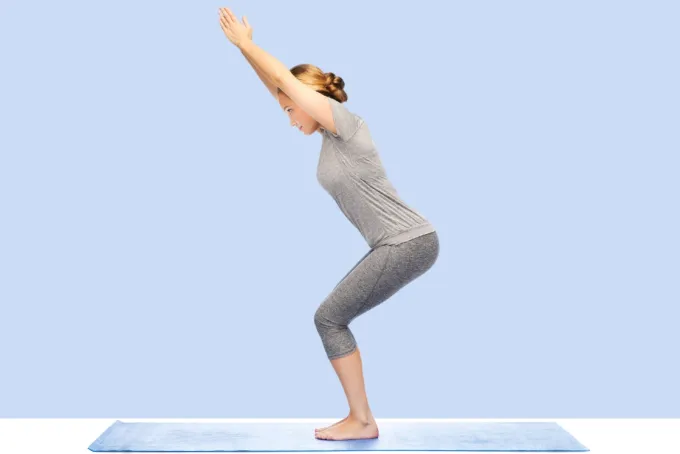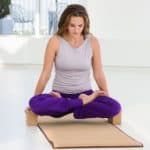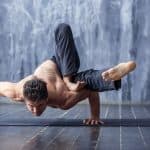A chair pose is a standing squat that let upper and lower body muscles strengthen simultaneously. While holding this pose for a while, you will feel an intense stretch in the shoulder & upper back. On regular practice, your quadriceps, gluteus, calves, and ankles get strengthened.
Benefits of Chair Pose
Utkatasana tones the shoulders, butt, hips, and back while strengthening the thighs and ankles. It is considered to be beneficial for treating flat feet since it stretches the shins and Achilles tendons.
Additionally, Utkatasana expands the chest and stretches the shoulders. Your heart and digestive system are toned by it. As you hold this position for a few breaths, your heart rate rises, boosting your circulatory and metabolic systems. It quickly and significantly raises body temperature!
The founder of contemporary yoga, T. Krishnamacharya, introduced the present variation of the Chair posture. It was once done as a full lower squatting stance, similar to Мalasana.
This pose serves as a transition from the standing position to the forward bend and from the forward bend to the sitting position in various Ashtanga and Vinyasa yoga sequences.
This position combines balance, stability, and strength because it is a transition pose between standing and sitting poses.
Chair posture comes after the mountain pose in the Sun Salutation B sequence.
B.K.S. Iyengar demonstrates in the Chair position in Light on Yoga that the torso should be slightly bowed to open the chest while the thighs should ideally be parallel to the floor.
It is known as the awkward chair position in Bikram yoga.
When you lower your bottom to rest on a seat, but the seat isn’t there, you’re said to be in an awkward chair pose since you have to contract your thighs and quadriceps to maintain the position. In a similar manner, we lower ourselves into a chair stance and sit on an unseen chair.
Meaning & Interpretation
Although the Sanskrit translation of this stance is complex, the English translation is straightforward.
A chair represents a seat or throne that elevates one above the typical ground level. In this way, the chair serves as a symbol of power that helps one stand out from the crowd.
As we are in this pose, we can feel the invisible seat or throne that is all we have, which is why Utkatasana is known as a “Powerful” or “Intense” pose. Even if this seat isn’t real, when we physically develop, we become “above the norm” mentally and spiritually.
Therefore, the Chair’s stance has a very deep meaning:
To use our leadership abilities, all we need to do is take a powerful seat from which we can easily lead all of life’s challenges.
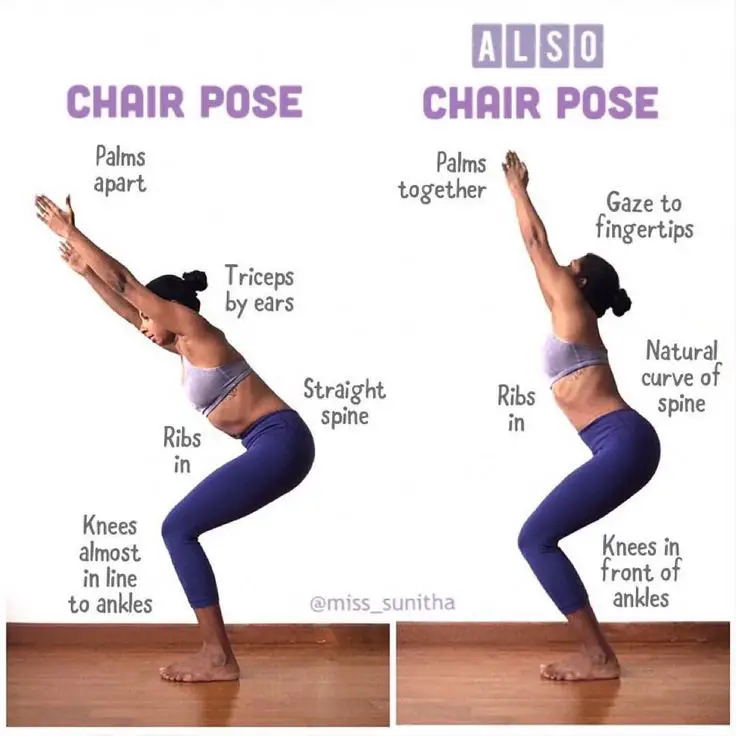
How to Do Chair Pose: Step-by-Step Instructions
To perform the Chair pose, simply come in a standing pose in front of your mat and follow the instructions below.
Step 1 – Preparing the Asana
Firstly, stand tall and straight in Tadasana (Mountain Pose).
Keep your feet hip-width apart and knees in line with your feet.
Take a couple of deep breaths here.
Step 2 – Getting Into the Asana
- Inhale and raise your arms over your head. Keep the arms straight and palms facing towards each other.
- Exhale, bend your knees and lower your hips till your thighs become almost parallel to the floor. Keep your knees just above the feet.
- Lean your upper body slightly forwards.
Note – Ideally, your torso should be 90 degrees to your thighs. You might have to raise your thighs a bit to form a 90-degree angle to your torso.
- Draw your shoulder blades downwards, into your upper back.
- Lengthen your spine and stretch the whole back.
- Now, gaze straight and start taking deep breaths for the flow of prana.
- Hold this position for 60 seconds breathing deeply.
Checkpoints
When you are performing the Chair Pose, you must take care of the following points.
- Your arms should be straight, and elbows close to your ears.
- Shoulders should be relaxed. Do not bring them close to your ears.
- Your back should be lengthened and your torso slightly bent forwards.
- Both knees should be just above the feet. Knees should not be ahead then your toes and toes should be pointing forwards.
- Your thighs should be almost parallel to the floor but slightly lifted.
Step 3 – Releasing the Asana
- When you are done, take a deeper breath.
- Then, with an inhalation, straighten your legs.
- Exhale, lower your arms, come back into Tadasana (Mountain Pose), as in Step 1, and relax.
- Note- If you are performing this asana in the Sun Salutation sequence, move directly into Standing Forward Fold (Uttanasana) after this pose ends.
Variations
Try some of the following modifications to intensify the pose or advance your practice of Utkatasana.
This version of Ardha Utkatasana (Half Chair Pose) involves placing the right foot over the left thigh, just above the left knee, with the knees bent. Bring your palms together in the Anjali Mudra at your heart while maintaining your balance. Continue to spread your hips, and throw your shoulders back. Repeat with the left leg after holding.
Parivrtta Utkatasana (Revolved Chair Pose) requires you to bend your knees and rotate your torso at the shoulders and chest. As you turn to the right, support yourself by resting your left elbow on the outside of your right knee. Open your chest, combine your palms in front of your chest, push the knee with the left elbow, and look up. On the left, repeat.
UtkataKonasanaVariation(GoddessPoseVariation) Rotate your feet to the outside and spread your feet wider than hip distance apart. You have two choices at this point: clasp your hands together in the Namaskara mudra or place your hands on your knees for extra support.
Tips and Modifications
- Place a folded blanket under your feet for better support and comfort.
- In the beginning, you can straighten the arms at shoulder level, parallel to the floor, instead of raising them over the head. It is much more comfortable for beginners.
- If your knees are getting closer unconsciously, you can place a yoga block between your lower thighs. This will help you to get a proper alignment.
- You can ask a friend to check your alignment. You can take help with the perfect alignment.
- If you find raising your hands easy, you can grab the clasp of both palms with the other over the head.
- To make this asana more challenging, you can gaze upward, between your both palms.
Benefits of Chair Pose
- The alignment of the body in the Chair pose is such a way that it puts a good amount of pressure on the lower body. Hence, it strengthens the lower body, especially the thighs, hip flexors, hamstrings, calves, and gluteus.
- Because Utkatasana is a good chest opening, it enhances diaphragm health and encourages healthy respiration. Asthma sufferers can benefit from this stance in this way.
- It makes the feet strong and maintains the good health of the arches of the feet. Thus, the chair pose is very beneficial in treating flat feet.
- The core muscles are greatly benefited by Chair Pose. This pose helps with digestion and detoxification by massaging the inside organs and muscles.
- This pose lengthens the spine and opens up the varying columns. It enhances spinal health and tones the entire spine.
- Utkarasana increases physical endurance and strength. It improves the stability and resiliency of the mind. Additionally, it is claimed that this pose will boost the energy pathways near the heart and heart chakra.
- The Chair Pose calms the nervous system and promotes mental tranquility. It calms the mind’s agitation and aids in enhancing mental clarity.
This poses greatly aids in easing stiffness in the arms, shoulders, back, and thighs. It increases the body’s total flexibility.
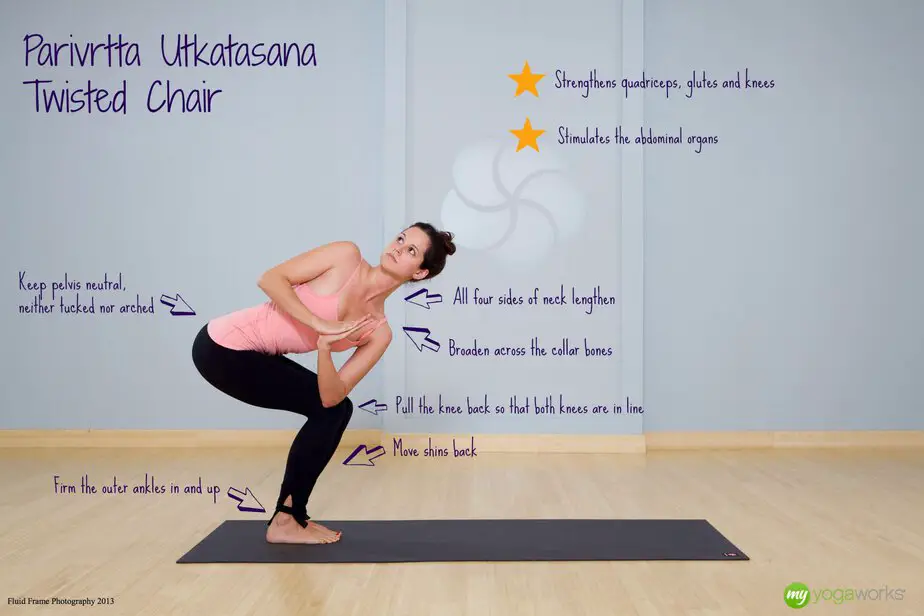
Precautions and Contraindications
- Perform this asana slowly and gently. Performing it in a hurry can result in the wrong alignment which may cause knee injury.
- It is better to perform Utkatasana on an empty stomach or perform it at least 4 hours after having a meal.
- If you have shoulder pain, do not raise your hands over your head. Instead, join your palms close to your chest, as in Anjali Mudra.
- During mensuration cycles, it is better to perform it under the supervision of an expert.
- If you have any injury on your feet, knees, thighs, spine, or shoulder, do not perform this asana at all.
- If you have healing issues like arthritis in the knees, back & knee pain, ligament problems, low blood pressure, or headaches, avoid this asana.
- In the case of pregnancy, do a modified version of the Chair pose.
Cautions
If you have headaches, low blood pressure, or insomnia right now, avoid doing Utkatasana. Work as best as you can within your particular range of limitations. Before practicing yoga, discuss any medical issues you may have with your doctor.
Chair pose tips for doing
A chair pose can build a lot of strength and stamina throughout the body when it’s done with correct alignment. Keep the following information in mind when practicing this pose:
- Maintain a slight arch in your back.
- Squeeze your thighs as close together as possible.
- Bring your thighs as parallel to the floor as possible.
- Draw your chest back and up, instead of reaching your torso forward.
- Keep your weight in your heels. Shifting the weight forward can overstress your knees and fatigue you quickly.
- Remember to breathe smoothly and evenly throughout the pose! Your heart rate will increase, but if your breath becomes strained, ease up until you can breathe deeply again.
A chair pose Practicing will strengthen your legs, torso, and arms in a flash. Holding it for extended periods will build stamina, endurance, and mental determination. Take it slowly, maintain your correct alignment, and be sure to find a variation or modification that works best for you. Then, enjoy the benefits as your yoga practice becomes fierce and powerful!
















